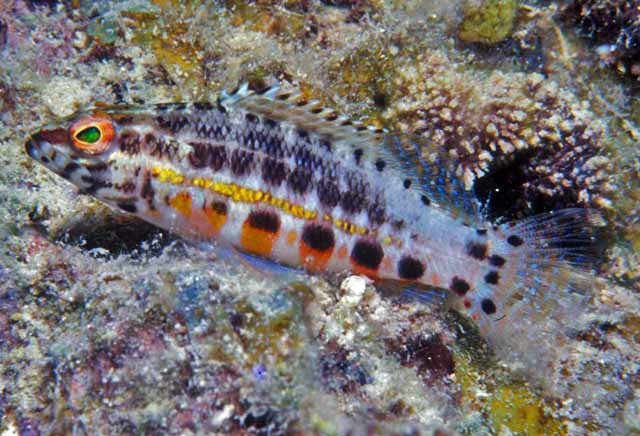Lantern Bass (Serranus baldwini)
• Small fish safe: ⚠️ With caution (may prey on very small fish)
• Small invert safe: ⚠️ No, will eat small ornamental inverts and CUC
• Coral safe: ✅ Yes
• Minimum tank size: 265 liters (70 gallons)
• Adult size: Up to 12 cm (4.7 inches)
• Diet: Carnivorous, feeding on small fish, crustaceans, and invertebrates
• Be aware of: Can be territorial; may prey on small fish and shrimp; requires caves and rockwork for shelter
Appearance and Coloration
The Lantern Bass is a strikingly patterned fish with a combination of orange, brown, black, and yellow stripesrunning along its elongated body. It features two prominent dark stripes along the upper half, a yellow mid-body stripe, and orange bands on the lower half, each topped with a black spot. The tail fin base has distinctive black spots, giving it a bold, eye-catching look.
While shallow-water individuals appear paler, those found in deeper waters tend to exhibit richer red, orange, or yellow hues. These colour variations make each individual unique, adding visual diversity to a reef tank.
Natural Habitat and Behavior
Native to the Western Atlantic Ocean, Serranus baldwini is found in the Caribbean, Gulf of Mexico, and Florida. It inhabits rocky reefs, coral rubble, and seagrass beds (especially turtle grass), often taking shelter among rocks, under ledges, or inside empty conch shells.
The Lantern Bass is typically found at depths of 1 to 80 meters (3 to 262 feet). It is a solitary species but can occasionally be seen in small, loosely associated groups. Like other Serranus species, it is synchronously hermaphroditic, meaning it possesses both male and female reproductive organs simultaneously. In the wild, a dominant fish may act as a male, mating with others in a harem-like system.
Despite its relatively small size, the Lantern Bass is a bold and confident predator, actively hunting small crustaceans and fish.
Tank Requirements and Water Parameters
• Minimum Tank Size: 70 gallons (265 liters)
• Water Parameters:
• Temperature: 22°C – 26°C (72°F – 78°F)
• pH: 8.1 – 8.4
• Specific Gravity: 1.020 – 1.025
• Aquascaping:
• Plenty of rockwork, caves, and crevices to provide hiding spots.
• Open swimming space is needed to allow natural foraging behavior.
• A deep sandbed is not required, but rocky structures should be stable.
• Lighting: Moderate to bright, mimicking natural reef conditions.
• Water Movement: Moderate flow, simulating reef currents.
Diet and Feeding
The Lantern Bass is a carnivorous predator, primarily hunting small fish and crustaceans in the wild. In captivity, it readily adapts to frozen and prepared foods.
• Natural Diet: Small crustaceans, tiny fish, and planktonic invertebrates.
• Captive Diet:
• Mysis shrimp
• Brine shrimp
• Finely chopped seafood (squid, shrimp, fish)
• High-quality marine pellets and flakes
• Live feeder shrimp (for finicky eaters)
Feeding Frequency: 1-2 times per day, ensuring a varied diet for optimal health.
Compatibility and Social Structure
• Temperament:
• Semi-aggressive, especially towards smaller fish or bottom dwellers.
• Can be territorial, especially if not provided with sufficient hiding spaces.
• Tank Mates:
• Best suited for semi-aggressive community tanks.
• Compatible with larger or similarly-sized clownfish, angelfish, tangs, and wrasses.
• Avoid small shrimp, tiny gobies, or nano fish, as they may be considered prey.
• Should not be housed with overly aggressive fish, such as large dottybacks or predatory triggers.
• Reef Compatibility: Coral-safe, but small invertebrates may be at risk.
Important Considerations
• Predatory Instincts: Will eat small fish and shrimp if they fit in its mouth.
• Territorial Behavior: May defend a preferred rock cave or hiding spot, especially in smaller tanks.
• Jumping Risk: Moderate risk—a secure lid is recommended.
• Adaptability: Generally hardy, disease-resistant, and well-suited for home aquariums.
